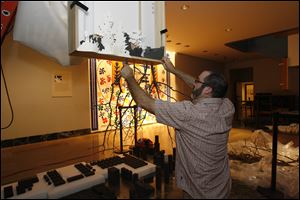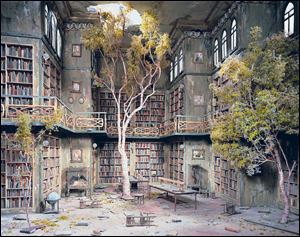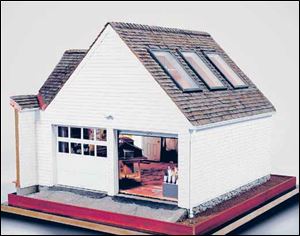
Small worlds loom large in new show at the museum
11/27/2011
Artist Gregory Euclide works on a section of "Take It With You-Toledo" on the first floor of the Toledo Museum of Art as part of the upcoming Small Worlds exhibit
THE BLADE/JETTA FRASER
Buy This Image

Artist Gregory Euclide works on a section of "Take It With You-Toledo" on the first floor of the Toledo Museum of Art as part of the upcoming Small Worlds exhibit
The universe is too vast a concept for most of us to grasp.
Break it down to a grain of sand, however, and we not only get it but we have intellectual capacity to spare.
Small Worlds, the new show at the Toledo Museum of Art, is a charming opportunity to adjust our perceptions in offbeat and thoughtful ways. The free exhibit that continues through March 25 includes 40-some pieces and an innovative 4½-minute film by two women and three men who play clever with small.
New York artist Lori Nix’s work is captivating with a dash of zany. She lent 19 large, colorful photographs that depict "rooms" where the apocalypse appears to have come and gone: a beauty parlor, corner bar, laundromat, church, and other scenes in disarray. And creeping in is the ultimate victor, Mother Nature. Rod Serling (Twilight Zone) would love these, but with the occasional rat or menacing pterodactyl, they’re a bit dark for Alice’s wonderland.
In one, a tree grows through the roof of a mansion’s library. In another, a crow plucks at a violin on the stage of the Majestic theater. Vines and giant fungi curate a grow-show in an abandoned art museum.
What’s astonishing is Nix’s process. These aren’t Photoshopped: she and her partner create each one in her New York apartment, with an eye toward the view she will use her large-format camera to photograph them.

Lori Nix builds tabletop-sized rooms and photographs them with a large-format camera.
"Building materials, lighting, issues of scale and space all become significant when you are recreating the world on a table top," Nix writes on her Web site. "There is usually one element I do not feel like creating, such as the piano in Majestic. I found the piano and then scaled the rest of the scene around it. The size of the piano determined the size of the diorama.
"My scenes can be as small as 50x60 centimeters and as large as 182 centimeters in diameter. It takes approximately seven months to build and photograph a scene. I build it for one angle of view and never move my camera from that spot. I will change the lighting, the placement of the objects and re-shoot until I’m fully satisfied with the results."
The first work you’ll see at the Toledo exhibit is by Gregory Euclide, a high-school art teacher from Minnesota who spent long days here in October, fabricating the entrance to the Canaday Gallery. His piece begins at the lower-level stairway where he has models of the museum’s campus (the main building’s roof studded with black solar panels) and the city of Toledo organized around the Maumee River. The scenes warrant a ground-level look followed by a stairway viewing.
The jarring aspect of Euclide’s piece is that his raw materials are mostly museum detritus: broken shipping crates and packing materials of foam and plastic. When preparing for a previous show in Florida, he realized how wasteful it was to pack his artwork in Styrofoam, plastic wrap, and wooden crates; ship them; store the crates; ship them back, and ultimately, throw everything away. "And here I am, a nature artist," he says.
He visited the museum’s storage building, selecting crates to which he attached root-like sticks, and foam that he cut into buildings and trees. Sheets of paper tumble from the second floor bridge to the first, their folds streaked blue to suggest water.
"How do you negotiate your existence in a world that’s destructive?" he asks. "I like my iPhone, I enjoy the benefits of the modern world, but I abhor the ways we get them."
The piece extends upward to a "covered bridge" of crates leading into the gallery. Many of the crates have white-circled peepholes. It’s hard to see the landscape dioramas inside, but holding a digital camera or cell phone to the hole can provide a magnified view.
People like to think that nature is untouched by humans, notes Amy Gilman, the museum curator who conceived of and pulled the show together. "But everything is mediated in some way by people," she says.
"And beginning the exhibit outside of the gallery is fun. It allows you to see a familiar space in a different way."

A tiny diorama of Joe Fig’s studio.
Make sure to step outside the museum on the Monroe Street side to visit the Tumbleweed Tiny House, 65 square feet of home-sweet-home with a cozy loft that sleeps two. The house will eventually be auctioned on eBay.
Small Places emphasizes a decided shift in the museum’s trajectory toward contemporary art. The previous exhibit in Canaday, the big gallery for temporary shows, featured 11 giant irregular polygons by Frank Stella, and another major show down the hall held paintings by Fernando Botero, often said to have earned more from his art than any other living artist. Last year, Canaday hosted the Psychedelic 60s: Posters from the Rock Era, and Bare Witness: Photographs by Gordon Parks. And in 2009, there was LitGraphic: The World of the Graphic Novel, a traveling show with 150 pieces by two dozen artists.
Money is tight, and several of these shows, mounted by Toledo museum staff, didn’t carry hefty rental fees, insurance, and shipping costs.
A striking addition is danDan (2009), a surreal short film, flavored with anime (Japanese-styled animation) that uses three projectors on three screens that angle in to each other like an hourglass.
Artist Tabaimo uses the soft colors and feel of traditional wood-block prints to make images of rooms of Japanese apartments. They slide from screen to screen, sometimes spilling their contents.
Tabaimo wants viewers to build their own story from her suggestions: a blood-spattered bed, a dove flying in and out, a woman splashing her face in a toilet, a tidy living room, and a naked man climbing into his refrigerator. The soundtrack is minimal and ominous. She begins her digitized drawings with hundreds of pictures she makes with pens and calligraphy brushes.
Charles Kanwischer’s 11 pieces are wonderfully quiet. He used pencils to sketch small black-and-white images of downtrodden streets within a mile of the museum. They’re gentle, nostalgic portraits of houses and the lonely spaces left when one is demolished. Home is where we create our small world, says Kanwischer, an associate professor of art at Bowling Green State University who lives in Waterville. Boxed note cards of his drawings are for sale in the Museum Store.
Joe Fig, of Brooklyn, lent four of his "diorama portraits." Notable is the miniaturized studio (23-by-60-by-40 inches) of painter Ross Bleckner. A peek inside shows Bleckner at his worktable amidst to-scale paint tubes and stained brushes, a splattered floor, and reproductions of his paintings stored in the attic. An audio interview with Bleckner can be heard here.
The dioramas grew out of a project in 2000 for which Fig visited artists in their studios and asked them how they worked. Their responses are in his 2009 book, Inside the Painter’s Studio, also for sale in the Museum Store. As painter Chuck Close says, they attest that "Inspiration is for amateurs, the rest of us just show up and get to work."
Small Worlds nudges the museum into new technology. An online catalog offers additional information about artists. It can be accessed at smallworlds.toledomuseum.org and via a QR code.
Free tours will be at 6:30 and 7 p.m. on Dec. 2, 9, 16, and 23, and at 2 p.m. Dec. 3, 10, and 17.
Contact Tahree Lane at: 419-724-6075 or tlane@theblade.com.